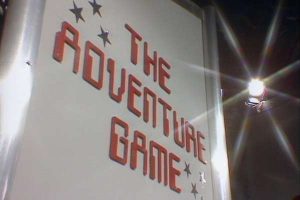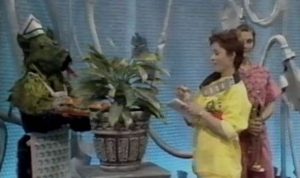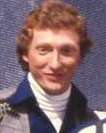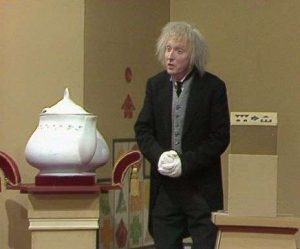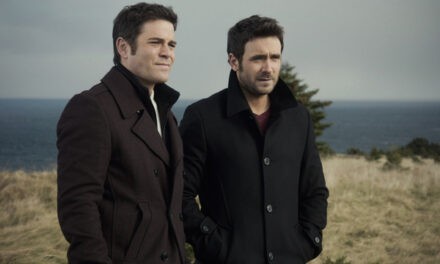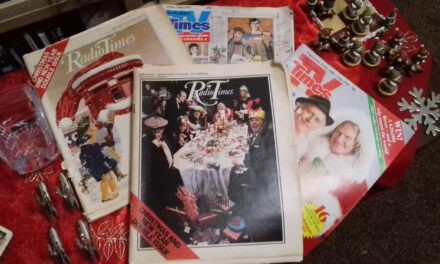I was talking to my colleague Robin Ellis the other day (not the Robin Ellis who used to be in Poldark; we couldn’t afford him):
‘Do you remember The Adventure Game, Robin?’ I asked.
He looked at me blankly, as is his wont.
‘Early 80s, puzzle-based game, set on the planet Arg?’
Not a sausage.
‘The characters were really alien dragons in disguise, and all their names were anagrams of the word ‘dragon’?
Silence deep as death.
‘The ruler of the planet was a grumbling aspidistra.’
‘Oh! The one with the coloured money?’
‘Drogna, yes…’
‘’Course I remember it.’
If you are of a certain age, mention of The Adventure Game may well bring a rush of similarly bizarre memories, strongly associated (for me at least) with Friday evenings[1] – much like other ‘Yay, school’s out!’ shows such as Monkey![2] and The Great Egg Race.
Variously compared to The Hitchhikers Guide to the Galaxy,[3] Dungeons and Dragons and the later Crystal Maze, The Adventure Game is one of the few items that almost tempted me to open an account with BBC Store (which I said wouldn’t last, and didn’t). However, it has now been released in its entirety (sort of)[4] on good old DVD, allowing television historians of a certain age to revisit a long lost alien world of irritable foliage and inscrutable currency.
The format is this: each week a trio of Terran visitors (a combination of two familiar TV faces and a member of the public) travel all the way to planet Arg (via Television Centre) and face a series of intellectual (and occasionally physical) tests in order to obtain the crystal that will then power their return shuttle to Earth. The formula varies slightly from series to series and episode to episode, but regular features include working out how to cross the Drogna Board (which initially requires the explorers to trace a logical route across a series of connected colours and patterns, before being amusingly repurposed as a game show in series three), the Maze (where one unfortunate player is unexpectedly zapped into a darkened room, only to be guided out by their fellows, watching on an infra-red screen, over the phone) and, from series two, the Vortex, which sees contestants making their way across a grid suspended in space, knowing that each move might result in them being vaporised by an unseen energy force. The show was devised by Patrick Dowling, who also presented the prologue for the second series, and comprised a combination of wit, whimsy and inventiveness that it is difficult to imagine being commissioned in the era of I’m a Celebrity (oh, the horror).
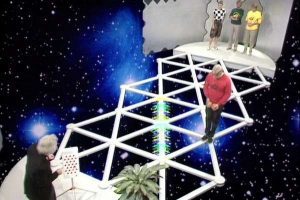 The three human contestants are both helped and hindered by their dragon hosts, most of whom opt to take human form in order not to intimidate the visitors. In a typical twist, the ‘alien’ actors are cited in the closing credits as being played by their Argond characters. For series one, these include none other than future newsreader Moira Stuart (Darong), who is very much the MC. She is joined by Charmian Gradwell (Gnoard), who takes over the meeting and greeting in series two, and later becomes anchor of Arg-o-Vision (the planetary television network) in series three. Her series four replacement is Sarah Lam (Dorgan), while other regulars include backward-speaking Bill Homewood (Rongad – or Ron Gad, depending on which episode you watch), and eccentric ‘butler’ Christopher Leaver (Gandor) – the only character to appear in every series. That is, unless one counts Arg’s leader, the mighty Rangdo. Referred to as ‘uncle’ by the other natives, the Rangdo must be pacified with the formal greeting ‘Gronda gronda!’ (ideally accompanied by a low bow), and appears as Ian Lassiter for several episodes in series one before turning into the afore-mentioned aspidistra, operated by none other than R2D2 Kenny Baker, and ultimately letting off steam as a testy teapot in series four.
The three human contestants are both helped and hindered by their dragon hosts, most of whom opt to take human form in order not to intimidate the visitors. In a typical twist, the ‘alien’ actors are cited in the closing credits as being played by their Argond characters. For series one, these include none other than future newsreader Moira Stuart (Darong), who is very much the MC. She is joined by Charmian Gradwell (Gnoard), who takes over the meeting and greeting in series two, and later becomes anchor of Arg-o-Vision (the planetary television network) in series three. Her series four replacement is Sarah Lam (Dorgan), while other regulars include backward-speaking Bill Homewood (Rongad – or Ron Gad, depending on which episode you watch), and eccentric ‘butler’ Christopher Leaver (Gandor) – the only character to appear in every series. That is, unless one counts Arg’s leader, the mighty Rangdo. Referred to as ‘uncle’ by the other natives, the Rangdo must be pacified with the formal greeting ‘Gronda gronda!’ (ideally accompanied by a low bow), and appears as Ian Lassiter for several episodes in series one before turning into the afore-mentioned aspidistra, operated by none other than R2D2 Kenny Baker, and ultimately letting off steam as a testy teapot in series four.
Several blogs have paid tribute to the programme’s eccentric charms, but the chief pleasure (for me) is contemplating the various levels of performance involved, on the part of both the contestants and their alien hosts. In particular, it is fascinating to observe the inflections employed by Christopher Leaver as Gandor, longest-serving of the Argonds, and for my money the real star of the show. This is, it is important to remember, a human actor playing an alien dragon that has taken on human form, who then adopts a specific persona for the purpose of interacting with the Earth explorers. In other words, humanoid Gandor does not behave the same way ‘in private’ as he does when in front of the Earthlings. This is made clear in the first broadcast episode,[5] when Gandor initially appears as an ordinary human dressed in fairly conventional garb (very much man from C&A in his shirt and knitted waistcoat; see below) and sporting Leaver’s own, reddish-blond hair. His manner, as he explains the various puzzles to Charmian Gradwell/Gnoard and Ian Lassiter/Uncle, is understated and naturalistic – very much the technical demonstrator. This is ‘off duty’ Gandor. However, when he meets Earth arrivals Elizabeth Estensen, Fred Harris (remember him?) and Mark Dugdale for the first time, Gandor has changed both costume and performance style, and is now wearing Edwardian butler garb, topped off with the first of several rather obvious white wigs. His manner has become, simultaneously, both overly solicitous (seeming to wish to help the visitors) and obtuse (adding to their confusion by misunderstanding or refusing to directly answer any questions), requiring a combination of punctilious politeness (‘Welcome, sirs and madam!’) and deliberate vagueness. This is a heightened, comedic performance – arguably what the contestants and audience would expect from an ‘other-worldly’ entity, given the scenario – but is not the ‘real’ Gandor, who has already been presented as an intelligent member of an alien race that derives pleasure from setting puzzles and watching others struggle to solve them. It is, however, a performance that is facilitated by actor Christopher Leaver’s quick wit and capacity for wordplay, frequently twisting the contestants’ statements and questions around in order to further confound them.
Interestingly, C&A Gandor disappears after the opening episodes of series one, and Leaver henceforth wears the butler costume throughout. However, unlike his fellow Argonds, he continues to vary his performance style to demonstrate when Gandor is ‘putting on a show’ for the contestants, and when he is ‘himself’ behind the scenes. For the latter, whether discussing the contestants’ progress with Gnoard (in series two and three), or explaining the planned puzzles to Dorgan (series four), his tone becomes brisk and business-like – at times even didactic. As the series progresses, Leaver adds further layers to his performance. From series two, contestants must attempt to purchase a ticket for their shuttle home using the various drogna[6] they have acquired over the course of the game. Gandor now switches from doddery butler to officious and despairing ticket vendor, happily fleecing the uncomprehending visitors and ensuring that he delays them long enough to miss the shuttle, thus obliging them to face the perils of the Vortex. In series three, a repurposed Drogna Game becomes the central set piece of most episodes, and Gandor transforms into a nasal and over-excitable game show host (‘It’s the Drooooooooooogna Game!!!’), the lovely Angord (one of the few Argonds not to adopt human form) acting as Anthea Redfern to his Brucie. Then, when the Earthlings begin competing against reigning champion the Red Salamander of Zardil (who wins every week – unsurprisingly, since the humans have to work out the rules as they go along), Gandor changes gear yet again, adopting the hushed tones of snooker commentator Ted Lowe to provide a wry commentary on the inevitable routing.
My focus on Leaver is not to say that the other Argond players do not do a fine job. Charmian Gradwell is, as one DVD reviewer notes, very appealing as Gnoard,[7] and, following a spell on Howard’s Way (truly entering another universe), has since become a distinguished voice coach, with a CV that includes the RSC. Sarah Lam is a little ingenuous as Dorgan in the final episodes, but backwards-talking Bill ‘Doogy Rev!’ Homewood skilfully conveys the fact that, not only can Rongad not be understood by his fellow Argonds, he also struggles to speak sdrawrof. However, these performers tend to remain in one fixed character throughout,[8] whereas Leaver successfully conveys more than one dimension to his role, adding a layer of sophistication that many young viewers (myself included) almost certainly failed to detect at the time.
So much for the Argonds; what of the humans? The chief pleasure here is watching celebs ‘play’ a version of themselves, in some cases struggling desperately not to appear foolish on national television. There are four main categories of contestant: actors, with whose ‘real life’ personae viewers would anyway be largely unfamiliar; presenters and pundits, whose attempts to maintain their public-facing image sometimes begin to slip when they come up against a thorny logic-based problem; sportspeople, who would be better known to the audience for their athletic endeavours than their off-screen personalities; and members of the public (including some academics; always a dry bunch) that the viewer has of course never heard of. The latter can be a mixed bag, often attempting to make up for their lack of charisma by taking charge from the outset (witness, for example, Robert Malos bossing Paul Darrow and Lesley Judd about). The presenters are usually quite good fun; James Burk takes it all very seriously, Richard Stillgoe is quick to adapt to Rongad’s backwards speech, and Noel Edmonds, who proves to be an inveterate giggler, is somehow not quite as annoying as one might have expected. The sportspeople also tend to be good eggs (Duncan Goodhew is every bit as nice as you’d expect), but some of the actors are a real surprise. Anyone who had only seen Paul Darrow as alpha male Avon in Blake’s 7 might be somewhat bemused by the polite, almost diffident gentleman that emerges, while Sandra Dickinson subverts her well established dizzy blonde image by picking up on several clues faster than Chris Serle.
 The Adventure Game being what it is, even the contestants get the chance to play on more than one level. Following her appearance at the end of series one, Lesley Judd becomes a regular in series two, playing ‘the Mole’: a duplicitous human who is really on the side of the Argonds, and deliberately misdirects her fellow Earthlings. It is always amusing to watch the contestants, who have been told from the outset that one of them is a fifth columnist, kicking out the ‘wrong’ Mole (‘Mole, mole, go to your hole!’), only for Judd (formerly so wholesome on Blue Peter) to gleefully reveal herself.
The Adventure Game being what it is, even the contestants get the chance to play on more than one level. Following her appearance at the end of series one, Lesley Judd becomes a regular in series two, playing ‘the Mole’: a duplicitous human who is really on the side of the Argonds, and deliberately misdirects her fellow Earthlings. It is always amusing to watch the contestants, who have been told from the outset that one of them is a fifth columnist, kicking out the ‘wrong’ Mole (‘Mole, mole, go to your hole!’), only for Judd (formerly so wholesome on Blue Peter) to gleefully reveal herself.
In many ways, The Adventure Game was ideal preparation for grown-up life. Not so much in its exercises in logical argument and lateral thinking (who needs them at university – right, undergrads?), which anyway became much simpler as the show progressed.[9] Rather, it teaches the simple but essential lesson that people and things are not always what they seem.
I’ve met quite a few dragons in academia, some of whom might actually be from another planet. Alas, few of them have proved to be as benign – or as fun – as the Argonds.
Dr Richard Hewett is the humanoid form taken by Argond academic Professor R. Gonad. Gnitirw sdrawkcab dna noitatpada, ecnamrofrep neercs llams, yrotsih noisivelet hsitirb edulcni noitasilaiceps fo seara.
Footnotes:
[1] Through a quick trawl through Genome shows that it was in fact broadcast on various days of the week between 1980 and 1986.
[2] I’ll blog about this another time, don’t worry. The nature of Monkey was irrepressible.
[3] Douglas Adams was apparently sounded out over taking part, but was too busy blowing up the planet Earth.
[4] Incredibly, four episodes were wiped by the BBC – though off-air recordings for three of these are included in the set. This was some time after Doctor Who fans kicked off about the mass junking of old episodes; Auntie Beeb just doesn’t learn, does she?
[5] There is a pilot lurking somewhere that did not make it onto the DVD.
[6] Arg’s main currency, which comes in a variety of shapes and colours.
[7] I had a major crush on her when I was twelve.
[8] Gradwell does briefly corpse when the aspidistra unexpectedly spits at Noel Edmonds. Who wouldn’t?
[9] In series one the visitors are expected to construct their own magnet; by the end of the run all they have to do is apply ‘Richard of York Gave Battle’ to the colour sequence on the Drogna Board. And some struggle with that.


